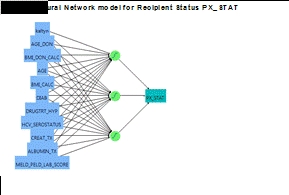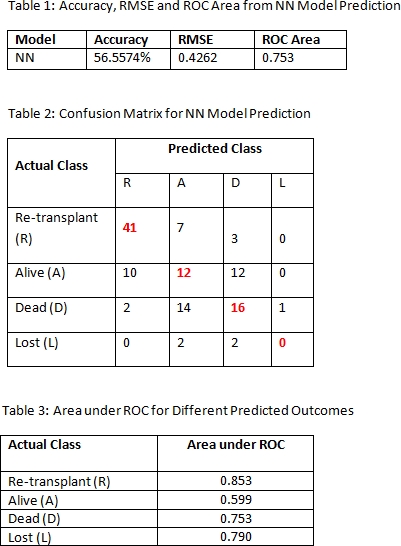Artificial Neural Networks in Kidney Allocation in Patients With Dual Organ (Liver-Kidney) Failure
1Transplant Nephrology, Methodist University Hospital Transplant Institute, Memphis, TN
2Dept of IT & Operations Management, Florida Atlantic University, Boca Raton, FL.
Meeting: 2015 American Transplant Congress
Abstract number: B136
Keywords: Allocation, Kidney/liver transplantation
Session Information
Session Name: Poster Session B: Liver - Kidney Issues in Liver Transplantation
Session Type: Poster Session
Date: Sunday, May 3, 2015
Session Time: 5:30pm-6:30pm
 Presentation Time: 5:30pm-6:30pm
Presentation Time: 5:30pm-6:30pm
Location: Exhibit Hall E
Background: Simultaneous liver / kidney transplantation has increased after the adoption of the Model for End-Stage Liver Disease score in 2002 by the United Network for Organ Sharing (UNOS). End stage liver disease patients with renal dysfunction have a complex choice of transplant options.
Objective: This study develops an artificial neural network (NN) based clinical decision support model to help identify the impact of kidney allocation on simultaneous kidney/liver transplant (SKLT) or a kidney after liver transplant (KALT).
Methods: The UNOS database was used to extract data on SKLT and KALT patients, who underwent kidney transplantation within a year of the liver transplant with a risk profile similar to the SKLT patients. A convenience sample of 358 patients with equal number (179) of SKLT and KALT patients was chosen. Specific donor and recipient independent variables were selected based on clinical theory and experience. The dependent outcome variable was the recipient status. A neural network with 11 nodes and one hidden layer was developed in WEKA using the variables identified from the UNOS database (Figure 1). A two-thirds of the data (N=236) was to train the model, with the remaining third (N = 122) used for validation. A total of 69 instances out of 122 instances are correctly classified. Prediction results are shown in Figure 2.
Results: The 56% accuracy in prediction is consistent with other studies in the literature related to neural network models in kidney survival studies.
Conclusion: The results are encouraging , but further research is needed with a larger dataset to improve the accuracy of the model and to guide clinical decision making for kidney allocation in patients with dual organ ( liver-kidney ) failure.


To cite this abstract in AMA style:
Rao V, Behara R. Artificial Neural Networks in Kidney Allocation in Patients With Dual Organ (Liver-Kidney) Failure [abstract]. Am J Transplant. 2015; 15 (suppl 3). https://atcmeetingabstracts.com/abstract/artificial-neural-networks-in-kidney-allocation-in-patients-with-dual-organ-liver-kidney-failure/. Accessed January 5, 2026.« Back to 2015 American Transplant Congress
